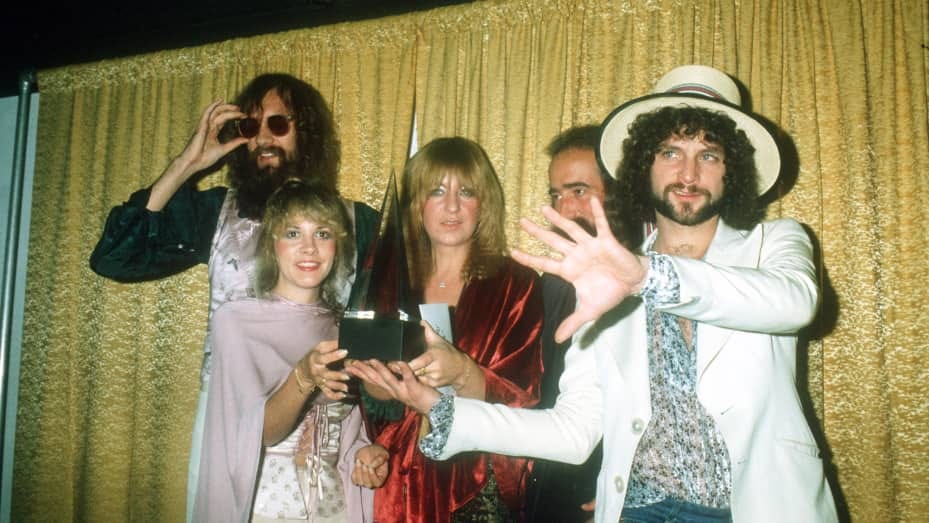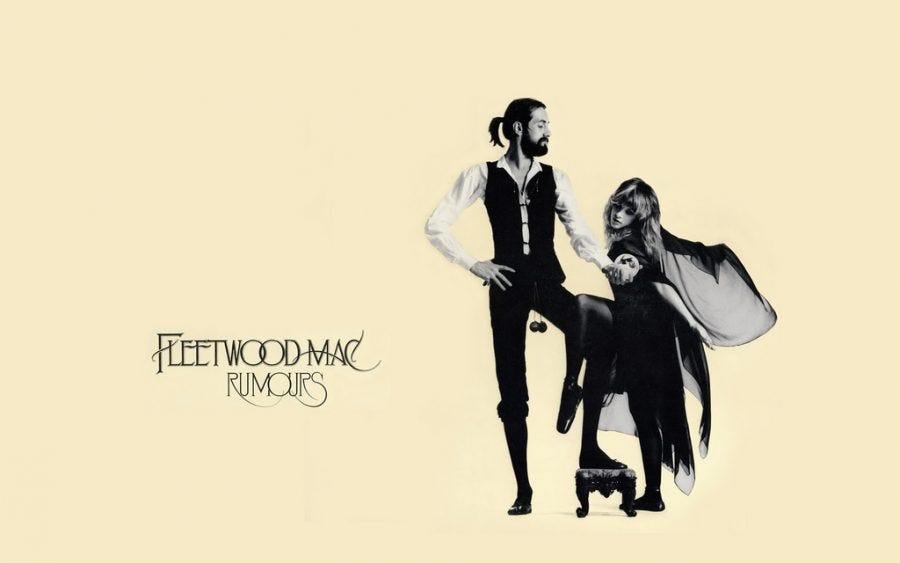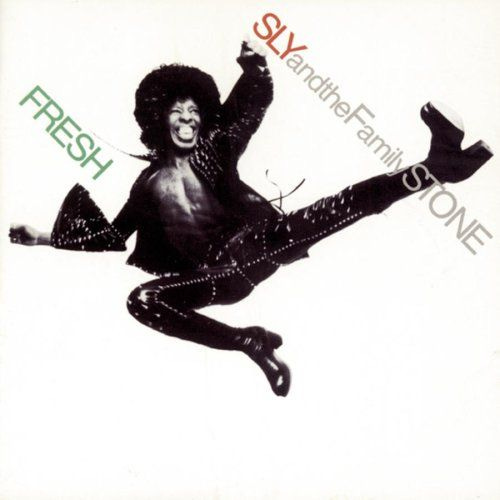👂EARthquake 1977: Fleetwood Mac's #1 Hit, Stevie Nicks' "Dreams," Influenced by Bee Gees & Spinners...Disco!
We all know Stevie Nicks' break-up with Lindsey Buckingham informed her lyrics. A new book, though, reveals Stevie's surprising musical inspiration for the band's only #1 hit.
Much has been written, over the decades, about the relationship merry-go-round within the 1970s-era Fleetwood Mac…that amid the million-selling albums, incessant radio airplay, and sold-out stadiums and arenas, Mac members were sleeping with one another so frequently, even Hollywood’s bed bugs were kept awake for weeks on end.
Rock history and Billboard charts are filled with Mac songs that have taken full advantage of the members’ copious encounters on the coital carousel, and the multiple boats, cars, houses (and cocaine) that were the result of that carnal carnival.
Stevie wrote about Lindsey, who wrote about Christine, who wrote about John, who wrote about Stevie, who wrote about Mick, who wrote about Christine (twice), who wrote about Lindsey, who probably got tired of writing at this point, and who could blame him?
Spreading Rumours
Rumours, the eleventh studio album by the British-American Fleetwood Mac (formed in London in 1967), was released on February 4, 1977 on Warner Bros. Records, and managed to whelp four Top Ten singles in the U.S.
In fact, as of February 2023, Rumours, according to BestSellingAlbums.org, has sold over 40 million copies worldwide, making it the sixth best-selling album of the 1970’s, and the 12th best-selling album of all time.
The album played a large role in “The Crash of ‘79,” according to this writer; first-hand accounts and observations (with boots on the ground) of the record industry’s cratering can be found here:

New Book Dispels (and adds a couple) Rumours
The recording of this eventual landmark album has seen more than its share of print. What’s new, though, is a surprising tome by one of the men who occupied the studio control room console during every note played by the band members, as well as every stony glare from one to another.
The producers who worked Rumours (at six different locations) were Richard Dashut, the band, and Ken Caillat (pictured above with daughter, Colbie, at a publishing event), author of the recently-released Making “Rumours.” He’s the father of pop singer, Colbie Caillat, 37, who recorded six albums between 2007 and 2016 (most for Republic/Universal Music Group).
According to Tom Breihan in the November 21, 2022 Lithub (and author of THE NUMBER ONES: Twenty Chart-Topping Hits That Reveal the History of Pop Music), “In spite of all this [relationship] chaos, Fleetwood Mac was a band of sonic perfectionists. The group put in long, expensive hours working on Rumours, its much-anticipated new album—playing songs over and over, then getting their producers to manually splice together tapes of their best parts.
“That left Stevie Nicks, the one non-perfectionist in the band, with nothing to do.”
This is the beginning of what turns out to be Stevie’s inspiration in writing the band’s only #1 hit in its history: “Dreams.”
“Nicks played piano, but she was the one member of Fleetwood Mac who didn’t usually play an instrument on record,” Breihan continues. “In his book Making “Rumours,” the album’s co-producer, Ken Caillat, writes that Nicks ‘was foremost a singer-songwriter; she wasn’t into the technical end of the music.
“‘So while all this experimentation was going on in the studio with the other members of the band, she was frustrated and pretty much bored out of her mind.’ Whenever Nicks could, she’d find a corner by herself.”
Her corner happened to be in the sprawling acreage of Sausalito’s Record Plant in northern California’s Bay Area (which closed its doors in 2009).
“Using the Record Plant had a lot of perks,” Breihan reports: “Two limos on call, a speedboat, a staff of cooks who could whip up hash cookies whenever necessary. One of the office rooms had a floor made entirely out of waterbed. Another had been turned into the Pit.”
The Pit, as it happens, was a functional recording studio designed in 1973 by Sly Stone (while recording his San Francisco-based Sly and the Family Stone’s Fresh album for Epic Records).
Sly, though, had a hippie-vibes party room in mind as his design element: The room’s floors, walls, and ceilings were covered in red shag carpet. At the center of the room was a black-velvet four-poster bed. One had to climb through a giant pair of fuzzy lips to get into it.
“During the Rumours sessions, the Pit was a hangout spot; Mick Fleetwood later said that the room ‘was usually occupied by people we didn’t know, tapping razors on mirrors.’ Sometimes, though, it was where Stevie Nicks went to get away from the rest of her band.”
“Dreams” is the song that Nicks wrote by herself on a Fender Rhodes keyboard in the Pit. Talking to Blender in 2005, Nicks remembered, “I sat down on the bed with my keyboard in front of me. I found a drum pattern, switched on my little cassette player, and wrote ‘Dreams’ in about 10 minutes.”
“Dreams” was aimed, lyrically, directly at Lindsey Buckingham, Nicks’s bandmate and ex. “The song doesn’t sound bitter. It radiates a mystical serenity. ‘Rhiannon,’ Nicks’s big hit from the 1975 Fleetwood Mac album, is about an ancient Welsh fertility goddess.
“With its talk of crystal visions and cleansing rains, ‘Dreams’ creates a similar feeling, but the lyrics are unmistakably pointed. The opening line is a poison dart: ‘Now, here you go again. You say you want your freedom. Well, who am I to keep you down?’ Elsewhere in the song, Nicks envisions Buckingham in the stillness of what he had and what he lost. It’s a poetic f***-you, but it’s still a f***-you.
“Lindsey Buckingham had to play on ‘Dreams.’ Buckingham’s guitar on the song finds a softly consoling tone, and its moaning, purring sound almost turns ‘Dreams’ into a duet. Buckingham also sings backup. You can hear his voice singing the words that Nicks wrote about him!
“For his part, Buckingham was also writing songs about Nicks, and she was also singing backup on those songs. ‘Dreams’ was the second single on Rumours. The first, the #10 hit ‘Go Your Own Way,’ is a Buckingham song where he sings that packing up and shacking up is all that Nicks wanted to do.
“Nicks has said that she ‘very much resented’ having to sing on ‘Go Your Own Way.’ She still did it. That was the way things were in Fleetwood Mac: The turmoil drove the music, and everyone played their part, helping out on songs even when those songs directly targeted them.”
“An Echo of Disco”: No Time Like the Prescient
“‘Dreams’ is a simple song, built on just two chords. The song’s arrangement is rich and subtle, and its pulse carries at least an echo of disco. Nicks wrote ‘Dreams’ with a preset drum-machine beat—’a dance beat,’ as she later called it.
“Before ‘Dreams’ had its title, the band referred to the track as ‘Spinners,’ since it reminded them of something the great Michigan orchestral soul group might’ve done!”
Related:
“The drums on the final version of ‘Dreams’ sound mechanistic because they are.”
“Ken Caillat got Mick Fleetwood to play eight simple bars, and Caillat then edited those bars into a tape loop. This was just before the Bee Gees would do something similar with their own #1 hit, ‘Stayin’ Alive,’” [produced by the Bee Gees, Albhy Galuten, and Karl Richardson, and released in December 1977]:
“By the mid-eighties, programmed drums would become a common pop-music trope. In the tape-loop groove of ‘Dreams,’ Fleetwood Mac were prescient.”
“But Fleetwood Mac were, at the very least, interested in disco.” I’m sorry…what?!
“That loop of Mick Fleetwood’s drums isn’t the same as a drum machine, though Stevie Nicks did use a pre-set beat when she was writing the song. Soon afterward, though, samplers would make it easy for producers to put together looped drum beats, and that new capability would drive rap and house and dance-pop.
“That simple, hypnotic pulse was a new thing for a blues-informed rock band like Fleetwood Mac, but Fleetwood Mac were, at the very least, interested in disco.
“On other tracks from the album, Lindsey Buckingham would coach Mick Fleetwood and John McVie to play with the same steady, basic beat that the Bee Gees had used on their disco breakthrough, ‘Jive Talkin’” [recorded January and February 1975, produced by Arif Mardin]:
“On ‘Dreams,’ the groove—those looped drums, the heavily-treated moans of the guitar, the understated swagger of John McVie’s bass line—conveys a numb sense of bliss. Stevie Nicks conveys something else.”
“In her tone alone, Nicks radiates both fond regret and seething anger. Where Buckingham sounds raw and frustrated on ‘Go Your Own Way’ (above), Nicks comes off as a mystical being who’s simply shaking her head at the small-minded pettiness of this man’s actions.
“She sounds like she’s above it, and like she’s both disappointed and lightly amused at the antics of mortal men. Even the voices behind Nicks—including that of Buckingham, the song’s mortal-man target—add to the sense of luxuriant remove.”
“Dreams” is Full-Immersion Pop Music
“It’s dense with meaning and allusion, and it creates a strange, tingly out-of-time feeling. Fleetwood Mac’s albums regularly sold better than their singles. Heard on the radio, ‘Dreams’ might not actively grab your attention in the same way as something like KC and the Sunshine Band’s ‘I’m Your Boogie Man,’ the song that ‘Dreams’ knocked out of the #1 spot.
“But in its intricate expansiveness, ‘Dreams’ creates its own uncanny sonic environment. That’s the quality that’s helped ‘Dreams’ linger in the sonic imagination.
“In the summer of 2020, for instance, ‘Dreams’ returned to prominence after Idaho skateboarder Nathan ‘Doggface’ Apodaca posted a video of himself riding down a highway, swigging from a bottle of Ocean Spray, and listening to ‘Dreams.’ That video went mega-viral for no real reason. It just had a vibe to it: That vibe was ‘Dreams.’”
FRONT ROW & BACKSTAGE thanks Founding Subscriber, Mark Chance, Third Man Records VP of A&R, for providing the article that inspired this post.
👉For more “Dreams,” from the POV of witnessing a talented busker (who knows his Stevie Nicks!) on a crowded commute on the Bay Area’s BART train, drop in on the always poignant, relevant, and humorous Steve Goldberg, and his recent gem, “Dreams of Loneliness” on his subscription-worthy Earworms & Song Loops Substack!












I love “Go Your Own Way,” but I was always struck by how histrionic it was compared to “Dreams,” where she barely reaches conversational volume while committing straight murder.
Oy, I finally came up for air to find time to read your prolific proliferations! This piece was dreamy! Lots of juicy, unknown (to me) nuggets of information here. What I love about "Dreams" is how the lyrics can be so specific to Stevie/Lindsey yet be interpreted personally to the listener.
And how the lyrics, in the context of the busker on the train that I witnessed, then take on new meaning for him. It's amazing how all the behind the scenes dirt you reference here can be fully and completely swept under the rug, the listener none the wiser.
Thanks for the shoutout!